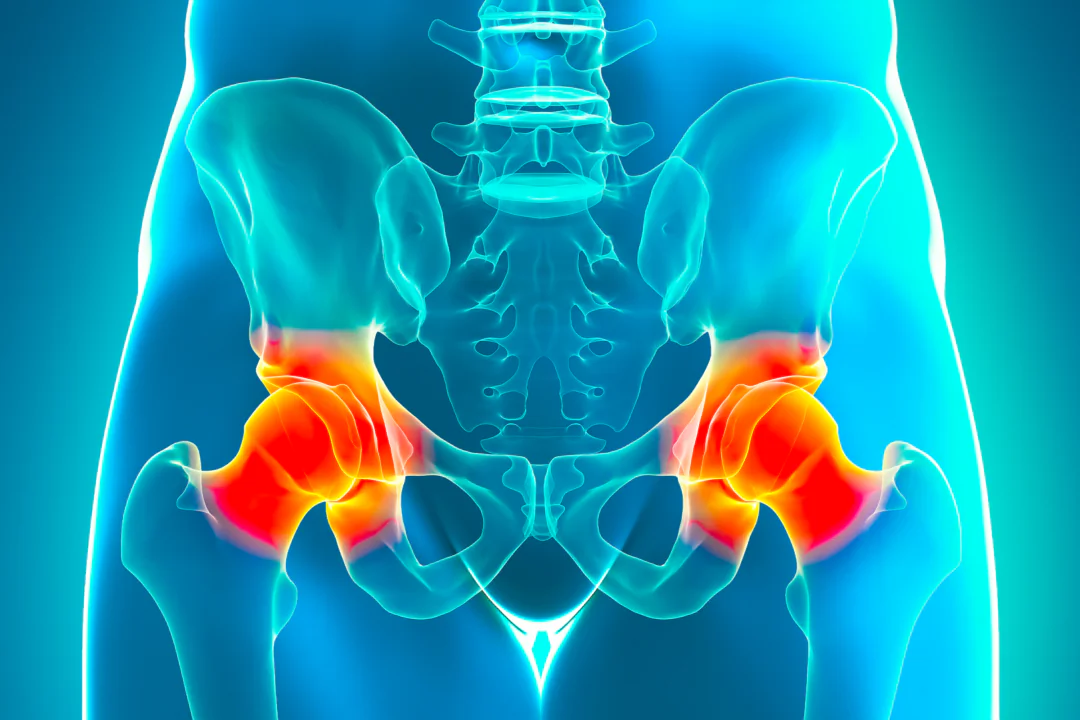Reactive arthritis is an uncommon form of arthritis that, like Guillain-Barré syndrome, often manifests in individuals who have experienced a gastrointestinal or genitourinary infection. After the patient’s body fights the infection, it turns on itself because of the development of an abnormal autoimmune response. Where Guillain-Barré syndrome attacks the nervous system, reactive arthritis attacks muscles and joints, and often almost everything else.
While reactive arthritis is associated with a wide array of symptoms, it often targets the lower body, including the legs, the sacroiliac joints where the lower spine and pelvis meet, and the lower back. It is most common in males in their 20s and 30s.
Regular exercise can help you to maintain strength and functional independence, especially in the face of an acute onset. The exercises recommended are a mix of intensities and can be easily modified to suit different needs.
While these exercises will not “cure” reactive arthritis, they are well-suited to help you manage your symptoms and enhance your ability to perform daily chores and self-care. I encourage you to do them at least five times a week, if possible.
Depending on your unique situation, seeking medical advice before starting an exercise program may be advisable.
6 Exercises to Manage Reactive Arthritis
1. Walking
If I could recommend only one exercise, it would be walking. It’s a universal medicine and can go a long way in combating stiffness, aching pain, and immobility.
Step 1: Start walking slowly for five minutes to warm up your joints and muscles.
Step 2: Accelerate to a normal walking pace for 20 minutes.
Step 3: Slow your rate of movement back to half speed for five minutes to cool down.
Step 4: Try to walk at least three times per week or, ideally, at least five times.
Be sure to hydrate well before and while walking to provide your joints and muscles with the necessary hydration.
2. Stepping Jacks
The stepping jack is a modification of the jumping jack. Where jumping jacks involve a hopping or jumping motion that can be too intense for some individuals with reactive arthritis, the stepping jack keeps one foot on the floor at all times.
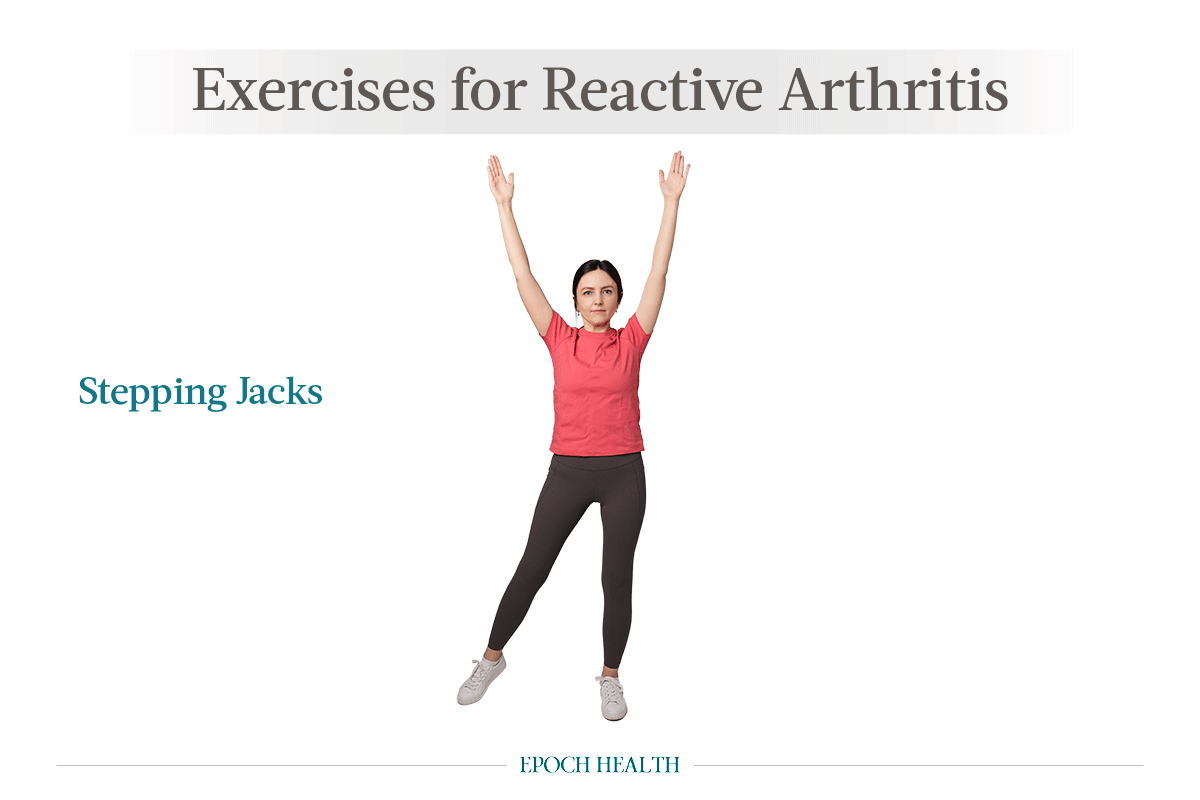
Step 1: Stand with your feet shoulder-width apart with your arms at your sides.
Step 2: Step to the right with your right foot while lifting your arms over your head.
Step 3: Bring your right foot back to the starting position while lowering your arms back down.
Step 4: Repeat the same pattern with your left foot.
Step 5: This counts as one repetition. Do three sets of 30 repetitions or exercise for two to three minutes.
3. Side-to-Side Floor Tap
These movements have a similar side-to-side movement pattern as the walking jacks, but instead of overhead hand movements, they include floor touches. Combining the two exercises in the same session provides a good “high/low” balance.
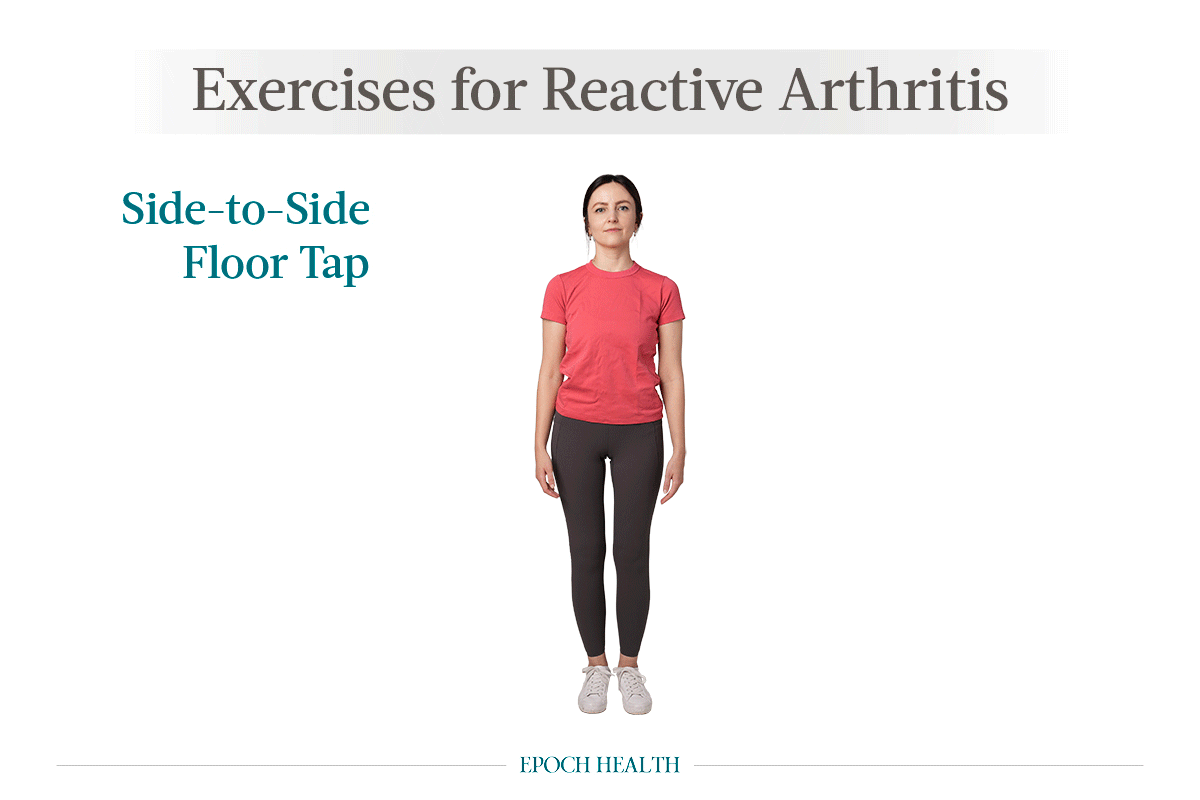
Step 1: Start by standing, leaving plenty of room for side-to-side movements with your feet together and your arms by your sides.
Step 2: Step to the right with your right foot, bend your right knee, and touch your right foot with your left hand.
Step 3: Come back up and step back into the starting position. Repeat the movement on your left side.
Step 4: This counts as one repetition. Try to perform three sets of 30 repetitions of this exercise and modify as needed.
While this “out, down, up, back” movement pattern may seem complicated at first, with a bit of practice, your movements can be smooth and continuous. You can intensify the exercise by accelerating the movements; just be careful not to sacrifice movement quality for speed.
4. Glute Bridges
Glute bridges strengthen your core muscles, hip joints, and spine.
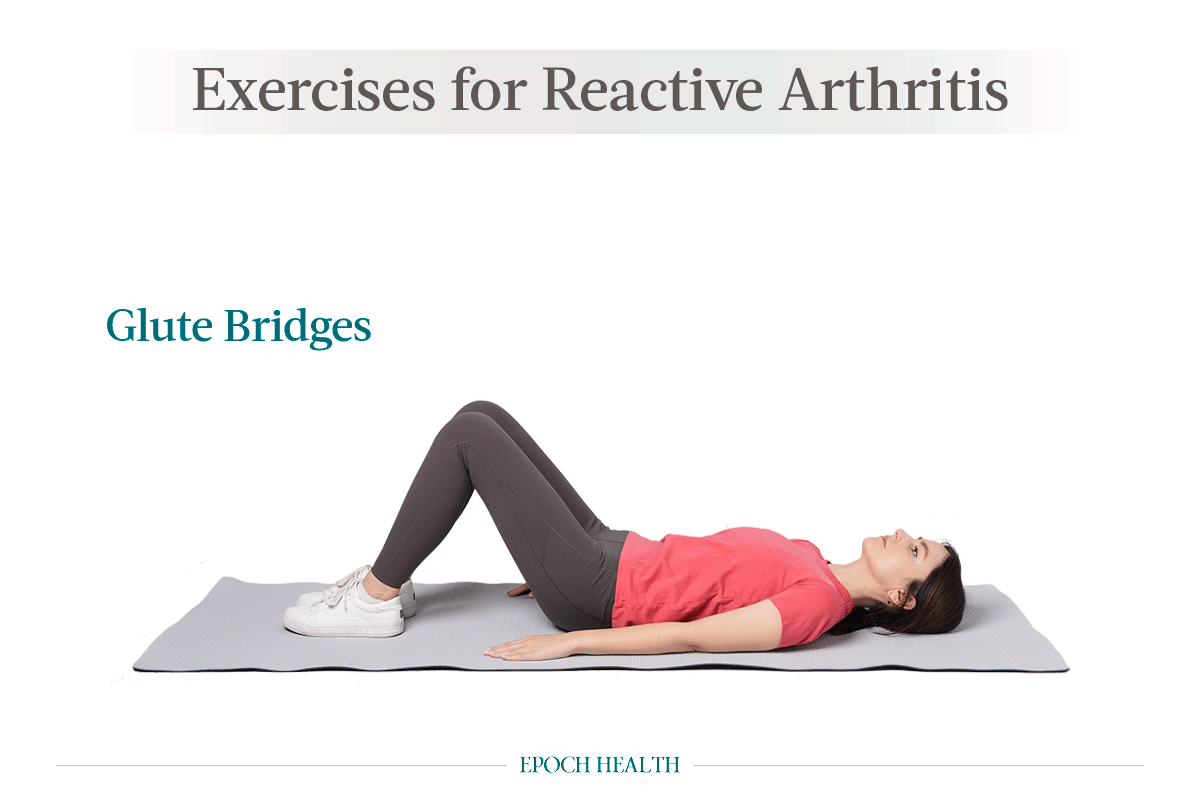
Step 1: Lie on your back on a supportive surface with your legs extended and arms by your sides.
Step 2: Bend your knees and bring both feet up until the bottom of your feet are flat on the floor. Keep your knees close together and lift your bottom until your upper legs are in a straight line with your trunk. Keep your back straight, and don’t overextend the movement. Visualize a straight line from your shoulders to your knees. Hold for three seconds before lowering back down.
Step 3: This counts as one set. Try to perform three sets of 20 repetitions.
Depending on your lower back involvement, this exercise can be particularly challenging, but you can modify it as needed.
5. Side Hops
The side hop exercise—also known as the lateral hop—is a simple but vigorous exercise to perform after you’ve warmed up with the earlier exercises. This exercise has cardiovascular benefits and is great for balance.
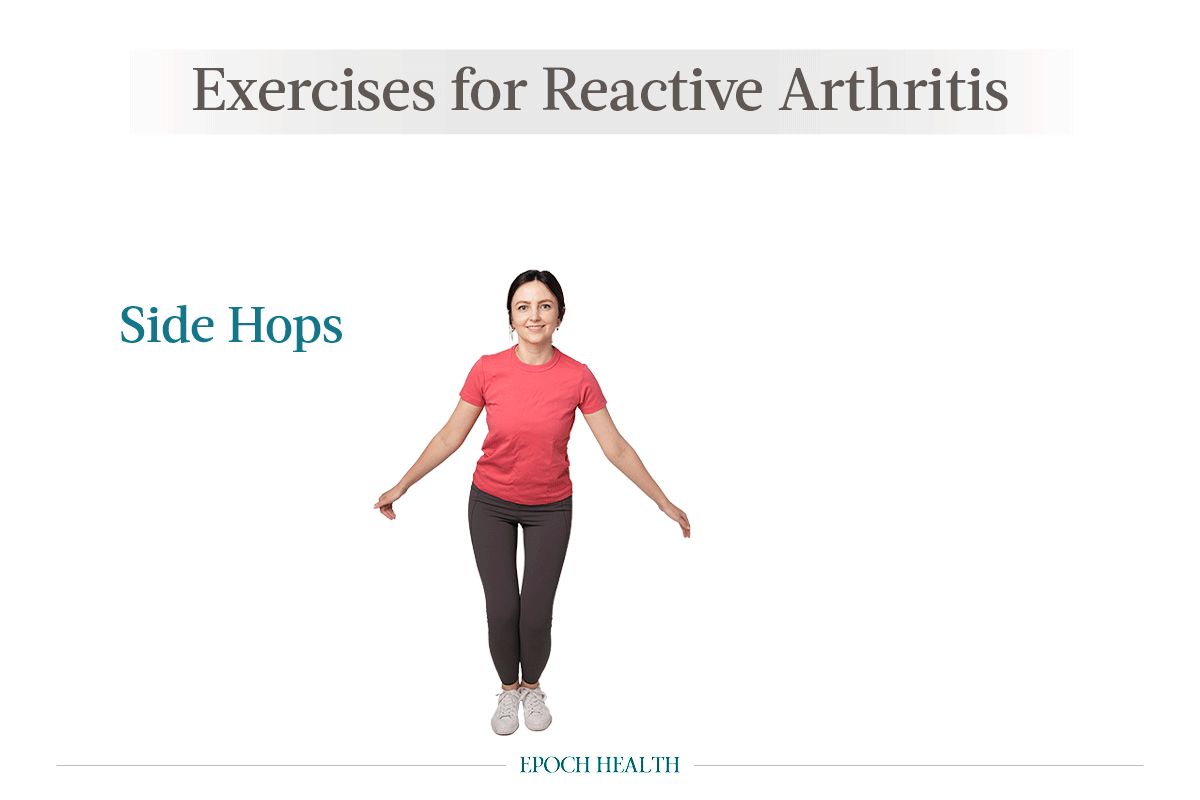
Step 1: Start by standing with your feet about shoulder-width apart, arms at your sides, and elbows bent so your hands are loosely fisted in front of your chest.
Step 2: Imagine there is an invisible line between your feet. Start hopping with both feet at the same time, about a foot to the left and right of the imaginary line.
Step 3: Hop for two minutes per set, and try to perform three sets.
Although this exercise involves a slight hopping movement, it is well-tolerated by many individuals with arthritis, especially after warming up.
6. Ski Jumps
Ski jumps are more of a whole-body movement than side hops and are similar to skiing, focusing on moving your body not only up and down but also in a lateral, side-to-side movement. These are a good progression from side hops if well-tolerated and are considered an intermediate exercise.

Step 1: Start by standing with your feet approximately shoulder-width apart with your elbows straight and your hands by your sides and slightly behind you.
Step 2: Imagine there is an invisible line between your feet. Using your entire body, jump with both feet at the same time, about a foot from each side of the imaginary line, while simultaneously using your arms to provide added momentum. Be sure to land firmly on both feet.
Step 3: Jump side-to-side for two minutes per set and try to do three sets.
While this exercise may seem hard at first, try to stay with it and simply do what you can to build up over time.
Taken as a whole, this series of exercises includes many reciprocal side-to-side movements; this is by design. Collectively, these exercises can work wonders with your balance and fluidity of movement to enhance your ability to perform daily tasks.
[note label=”Next” title=”Part 10 – The Impossible Lid: Opening Containers When You Have Arthritis” hyperlink=”https://m.theepochtimes.com/health/the-impossible-lid-opening-containers-when-you-have-arthritis-5581195″ description=”Arthritis can make opening containers nearly impossible. This advice from occupational therapists with expertise in hand strength can make a difference.”][/note]
Views expressed in this article are the opinions of the author and do not necessarily reflect the views of The Epoch Times. Epoch Health welcomes professional discussion and friendly debate. To submit an opinion piece, please follow these guidelines and submit through our form here.

